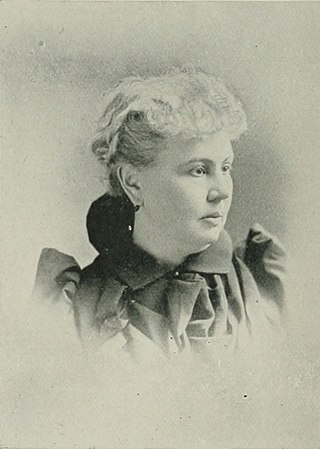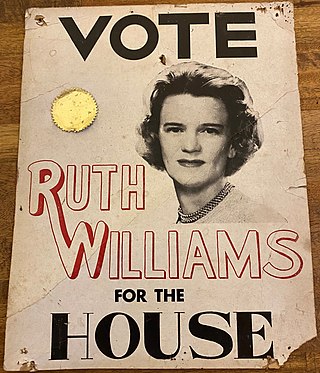The Woman's Christian Temperance Union (WCTU) is an international temperance organization, originating among women in the United States Prohibition movement. It was among the first organizations of women devoted to social reform with a program that "linked the religious and the secular through concerted and far-reaching reform strategies based on applied Christianity." It plays an influential role in the temperance movement. The organization supported the 18th Amendment and was also influential in social reform issues that came to prominence in the progressive era.

Frances Elizabeth Caroline Willard was an American educator, temperance reformer, and women's suffragist. Willard became the national president of Woman's Christian Temperance Union (WCTU) in 1879 and remained president until her death in 1898. Her influence continued in the next decades, as the Eighteenth and Nineteenth Amendments to the United States Constitution were adopted. Willard developed the slogan "Do Everything" for the WCTU and encouraged members to engage in a broad array of social reforms by lobbying, petitioning, preaching, publishing, and education. During her lifetime, Willard succeeded in raising the age of consent in many states as well as passing labor reforms including the eight-hour work day. Her vision also encompassed prison reform, scientific temperance instruction, Christian socialism, and the global expansion of women's rights.

Margaret Bright Lucas was a British temperance activist and suffragist. She served as president of the British Women's Temperance Association (BWTA), the World's Woman's Christian Temperance Union (WCTU), and the Bloomsbury branch of the Women's Liberal Association.

Magnolia Cemetery is a historic rural cemetery in Charleston, South Carolina. The first board for the cemetery was assembled in 1849 with Edward C. Jones as the architect. It was dedicated in 1850; Charles Fraser delivered the dedication address. It was listed on the National Register of Historic Places as a Historic District in 1978.
Elsie Ward (1871–1923) was an American sculptor born in Fayette, Missouri. Her collection largely consists of bronze and other metal sculptures. Ward worked on a host of diverse works of art, but "her specialty was portraits, busts, and reliefs".

Carrie Belle Kearney was an American temperance reformer, suffragist, teacher, white supremacist, and the first woman elected to the Mississippi State Senate.

Mary Mendenhall Hobbs, was an American Quaker advocate for women's education, temperance, and suffrage, based in North Carolina. Her campaigning to improve women's education supported the founding of the University of North Carolina at Greensboro in 1891.

Caroline Elizabeth Merrick was an American writer and temperance worker. She is the author of Old Times in Dixie Land: a Southern Matron's Memories (1901). Taking an active part in the charitable and philanthropic movements of New Orleans, she served as president of the Ladies' Sanitary and Benevolent Association, of the Woman's Foreign Missionary Society of the Methodist Episcopal Church, and of the Woman's League of Louisiana.

Clara Christiana Morgan Chapin was a British-born American woman suffragist, temperance worker, and editor.

Frances Julia Barnes was an American temperance reformer. She served as General Secretary of the Young Woman's Branch of the Woman's Christian Temperance Union (WCTU).

Clara Cleghorn Hoffman was an American temperance activist. She was a lecturer within the National Woman's Christian Temperance Union (WCTU). Hoffman was born in New York state, but became identified with the white-ribbon movement in Kansas City, Missouri, giving up her position as principal of a school to enter its ranks. Under her leadership, Missouri became one of the best organized of states, while her growing power and popularity as a leader were evidenced by the fact that for five years of her state presidency, there was not one ballot cast against her. At the Chicago Convention in 1893, she was made Assistant Recording Secretary, and at Cleveland, 1894, chosen Recording Secretary to succeed Lillian M. N. Stevens.

Virginia Durant Covington Young was an American suffragist, temperance activist, author, and newspaper editor and owner. After serving as editor of South Carolina's Fairfax Enterprise weekly newspaper, Young became the newspaper's sole owner in 1899. Her work for women's suffrage in South Carolina was widely recognized, though South Carolinian women gained the right to vote years after Young's death.

Marietta Bones was an American woman suffragist, social reformer, and philanthropist. In 1881 Bones was elected vice-president of the National Woman Suffrage Association (NWSA) and annually re-elected for nine years. In 1890 suffragist Susan B. Anthony and supporters of the movement merged the National Women Suffrage Association into the National American Women Suffrage Association (NAWSA). In 1882, Bones made her first appearance as a public speaker in Webster, soon to be Webster, South Dakota, where she later resided. She was an active temperance worker, and was secretary of the first Non-Partisan National Woman's Christian Temperance Union in 1889. She took great interest in all reform and charitable institutions.

A. Viola Neblett was an American temperance activist, suffragist, and women's rights pioneer. She was an indefatigable worker for temperance in Greenville, South Carolina, and was the first woman in her state to declare herself unreservedly for woman suffrage over her own signature in the public prints. She was a notable participant in the annual convention of this Association at Atlanta in 1895, and later spent months in Washington, D.C. in the endeavor to secure the enfranchisement of women under the new constitution of South Carolina. In her last days, she planned a bequest to the National American Woman Suffrage Association. In her own town, she founded and endowed the Neblett Free Library, her home becoming Greenville's first library.

Dora V. Wheelock was an American activist and writer involved in the temperance movement. She served as president of the Nebraska state branch of the Woman's Christian Temperance Union (WCTU), the Nebraska state superintendent of press work, and a reporter for The Union Signal for Nebraska. She wrote much including for Youth's Companion. Wheelock was also elected to the board of education of Beatrice, Nebraska.
Nettie Sanford Chapin was a 19th-century American teacher, historian, author, newspaper publisher, suffragist, and activist. Chapin wrote mostly prose. She also wrote on Iowa history, and published several small books herself. While residing at Washington, D.C. for several winters, she wrote concerning society and fashionable Washington circles. In 1875, she began the publication of The Ladies Bureau, the first newspaper published west of Chicago by a woman. Chapin served as chair of the National Committee of the National Equal Rights Party.

Ruth Cupp was an American lawyer, legislator, judge, and author in South Carolina. She was the first woman admitted to the Charleston County Bar Association. She served as an associate probate judge, and was elected to the South Carolina House of Representatives. She was also a columnist for Charleston's The Post and Courier.

Abby Fisher Leavitt was an American social reformer and one of the prominent figures of the Ohio Women's Crusade. Leavitt also served as Secretary of the Baptist Women's Foreign Missionary Society of Ohio and Treasurer of the Women's Crusade Temperance Union. She was the leader of the "Praying Band", who, in the spring of 1874, daily marched down to the esplanade of Cincinnati, visiting saloons, and holding meetings inside or outside of liquor saloons, and on one occasion, was arrested and temporarily imprisoned for her temerity. She was a co-publisher of the newspaper of the National Woman's Christian Temperance Union (WCTU). In 1891, as the "Round the World Missionary of the WCTU", the World's WCTU elected Leavitt its life president.

Ella M. George was an American teacher, lecturer, and social reformer. For 25 years, she was a teacher in Pittsburgh, Pennsylvania. A long-time leader in temperance and other moral reforms, George served as Pennsylvania state president of the Woman's Christian Temperance Union (WCTU) for 22 years. While she deplored the methods of militant suffragettes, she held that equal suffrage would go a long way toward winning the victory the WCTU sought. She also sat on the board of directors of the National Reform Association, briefly serving as its executive secretary.

Margaret Dye Ellis was an American social reformer, lobbyist, and correspondent active in the temperance movement. She served as Superintendent, Legislation, for the National Woman's Christian Temperance Union (W.C.T.U.). in Washington, D.C. for 17 years, looking after reform measures in Congress. Throughtout those years, she contributed to the W.C.T.U.'s organ, The Union Signal, a weekly, "Our Washington Letter". She favored woman suffrage and was a social purity activist. Ellis, aided by local and State unions, helped greatly in securing the passage of many reform laws.



















